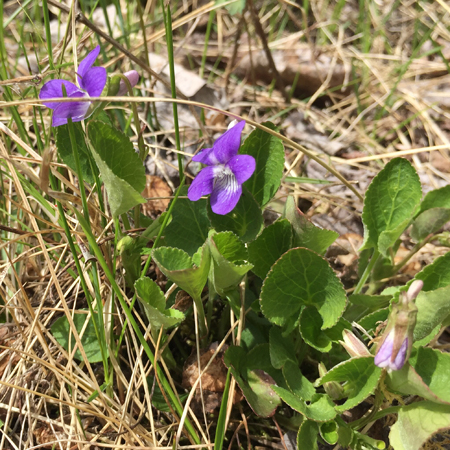Viola aduncoides A.Löve & D.Löve
Common names:
Northwestern Hook-spurred Violet
Synonyms:
Viola aduncoides A.Löve & D.Löve, Bot. Not. 128(4): 516. 1976 ["1975"]. TYPE: Canada, Manitoba, Árnes, meadow along poplar shrub, May 5, 1953, Löve & Löve 5744 (HOLOTYPE: "Herb. Winnipeg" [WIN?]).
Description:
[Description largely verbatim from V. adunca except for distinguishing traits from V. adunca!] Caulescent perennials from somewhat slender rhizome, stems ascending in flower but commonly reclining in fruit, commonly > 2, < 16 cm tall; stems, foliage and peduncles blue-green, puberulent (very rarely glabrous in boreal populations), hairs of foliage and peduncle (when present) up to 0.22 mm long, guard cells 25-36 µm long; leaves cauline and basal, cauline distributed along stem; stipules free, deeply incised; leaves ascending to spreading, leaf blades undivided, largest ≤ 33 × 28 mm, narrowly ovate-triangular to narrowly ovate, base broadly rounded to subcordate, margins subcrenate to subentire and often revolute, ciliolate (rarely eciliate), apex narrowly rounded; chasmogamous flower ≤ 16 mm; calyx glabrous or sepals puberulent along midvein, eciliate; lowest sepals linear-lanceolate to lanceolate, acute; auricles short and entire or prominent and erose, not elongating in fruit; corolla medium to dark blue, throat white; spur elongate, slender, 5–7 mm, blue to white; lateral petals densely bearded with filiform hairs, spurred petal glabrous; Style uniformly cylindrical or gradually expanding to head; projections on head (when present) sparse, conical or globular, their length up to 1/10 the width of the style head; tip below stigmatic orifice gradually bent upward at 45 °; pollen grains 4.1-4.9 µ in diameter; cleistogamous flowers produced after chasmogamous; capsule 6–9 mm, green drying tan, unspotted or with fine red spots, glabrous; seeds 1.5–2.0 × 0.9–1.0 mm, medium to dark brown, unspotted; 2n=40.
Similar species:
This boreal western Canadian species, not yet confirmed in our region, has been confused with the transcontinental diploid V. adunca but can be distinguished by the several style features and slightly longer foliage puberulence as noted in the key. It is immediately distinct from V. labradorica by its dark blue-green typically puberulent foliage, narrowly ovate leaf blades with subentire to shallowly crenate and often revolute margins, and deeply lacerate stipules.
Ecology:
Dry sandy and rocky ground in forests and parklands, rock crevices or talus.
Distribution:
Restricted to Canada in the n. Great Plains and Pacific Northwest, distributed from the n. shore of Lake Superior (and possibly also extreme ne. MN) to NT and YT, south to Vancouver Island, BC.
Rarity:
None.
Phenology:
Presumably same as V. adunca.
Affinities:
This species belongs to the Rostrate Violet lineage, sect. Viola, subsect. Rostratae (Kupffer.) W.Becker.
Hybrids:
Hybridizes with V. adunca, creating sterile triploid hybrids (McPherson and Packer 1974). The hybrid is sterile, neither reproducing by chasmogamous flowers nor setting normal cleistogamous capsules or seeds.
Comments:
This species was characterized as a tetraploid cytotype by McPherson and Packer (1974) and later named as a species by Löve and Löve (1976). Previously it was implicitly included in a broadly delimited V. adunca Sm. by Brainerd (1921b), Brainerd Baird (1942), Fernald (1950), Alexander (1963) and Russell (1965). Gleason and Cronquist (1991), Ballard (1992, 1995) and Little and McKinney (2015) synonymized it under V. adunca. For more details, see V. adunca. The common name of Northwestern Hook-spurred Violet was coined to distinguish it from the widespread Hook-spurred Violet, V. adunca. The images used were taken from w.-c. Manitoba and e.-c. British Columbia, in the heart of the range of V. aduncoides, and are presumed to represent the species. For full commentary, see V. adunca. The map in McPherson and Packer (1974) suggests a confirmed V. aduncoides specimen in the extreme northeastern portion of Minnesota–the only U.S. location currently–not far south of the Thundar Bay District, but Gordon McPherson (pers. comm.) was unable to verify the veracity of that record. The species should be sought in the boreal region of the midwestern and western U.S.
Literature Cited:
Alexander, E. J. 1963. Violaceae. In Gleason, H. A., The new Britton and Brown illustrated flora of the northeastern United States and adjacent Canada. Hafner Publishing Co., Inc., New York, NY. 552-567.
Ballard Jr., H. E. 1992. Systematics of Viola section Viola in North America north of Mexico. M.S. thesis. Central Michigan University, Mount Pleasant, MI.
Ballard Jr., H. E. 1995 ["1994"]. Violets of Michigan. Michigan Botanist 33: 131-199.
Brainerd, E. 1921b. Violets of North America. Vermont Agricultural Experiment Station Bulletin 224: 1–172.
Brainerd Baird, V. 1942. Wild violets of North America. University of California Press, Berkeley, CA.
Fernald, M. L. 1950. Violaceae. In Gray’s Manual of Botany, 8th ed. American Book Company, New York, NY. 1022-1042.
Gleason, H. A. and A. Cronquist. 1991. Violaceae. In Manual of vascular plants of northeastern United States and adjacent Canada, 2nd ed. New York Botanical Garden, Bronx, NY. 157-163.
Little, R. J., and L. E. McKinney. 2015. Violaceae. In Flora of North America: Cucurbitaceae to Droseraceae, 106. Oxford University Press, New York, NY.
Löve, Á., and D. Löve. 1976. Nomenclatural notes on Arctic plants. Botaniska Notiser 128: 497-523.
McPherson, G. D., and J. G. Packer. 1974. A contribution to the taxonomy of Viola adunca. Canadian Journal of Botany 52: 895–902.
Russell, N. H. 1965. Violets (Viola) of the central and eastern United States: An introductory survey. Sida 2: 1–113.

Chasmogamous flowering habit by Bev Ramey, iNaturalist #37121273

Chasmogamous flowering habit by Mary Krieger, iNaturalist #6311448

Map by McPherson and Packer (1974); open circles=V. adunca, closed circles=V. aduncoides